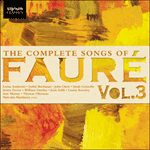The poem, one of Hugo’s most celebrated lyrics, appears in the collection entitled
Les rayons et les ombres (1840) as No xxxiv. This is an extended structure of thirty-eight strophes. Of these Fauré selected verses 1 and 8 for the opening
Grave, and then 9, 10, 31 and 32 for the
Allegro non troppo. Victor Hugo himself is ‘Olympio’ (subsequently used as a nickname by his contemporaries). The background of the poem is the poet’s love for Juliette Drouet. In 1834 and 1835 the couple dallied in the woods that lay between their respective holiday lodgings in the valley of the Bièvre river, not far from Paris. (Hugo was a guest at the Château des Roches with his wife and young family.) After this secret idyll which occasioned some of his greatest love poetry, Hugo revisited the region on his own in 1837 when, as ‘Olympio’, he castigates nature for being impervious to the former presence of the lovers. Nevertheless he realizes that a landscape, however evocative, can never retain the imprint of human memories.
Tristesse d’Olympio is also a lament for the gradual waning of the ardent passion Hugo had known with Juliette (although she remained devoted to her beloved ‘Toto’ until the end of her life). The composer has cleverly cut the poem, but Fauré’s song fails to encompass Hugo’s philosophical scope; it is no surprise the composer withheld it from publication. The music, however, aspires to something of the poet’s grandeur: the modal feel of the opening slow section is typical of Fauré in elegiac mood, a spaciousness that suits the structure (AABCCB) of the two six-line strophes. The solemnity of this music is prophetic of such songs as
Seule!,
L’absent, and
Au cimetière. This section ends with the words ‘Alors il s’écria:’. After this colon Hugo places the poem’s remaining thirty strophes – all quatrains – in inverted commas as Olympio speaks in the first person. This change of voice ushers in a new, faster tempo – restless accompanying quavers supporting a terse and desperate vocal line where the ABAB rhymes tumble out across the stave. This moto perpetuo, where the piano-writing carries the voice ineluctably forward, is prophetic of
Toujours, but it also has an intensity that brings to mind
J’ai presque peur, en vérité from
La bonne chanson. Both of these songs can be heard later on this disc.
from notes by Graham Johnson © 2005
Ce poème, l’un des plus célèbres de Hugo, est le noXXXIV du recueil intitulé
Les rayons et les ombres (1840). De cette vaste structure de trente-huit strophes, Fauré a extrait les nos1, 8, 9, 10, 31 et 32—les deux premières pour le
Grave initial, les autres pour l’
Allegro non troppo. Victor Hugo lui-même est Olympio (ainsi le surnommeront ses contemporains) et ce poème lui fut inspiré par son amour pour Juliette Drouet. En 1834 et en 1835, le couple folâtra dans les boix situés entre leurs meublés de vacances respectifs, dans la vallée de la Bièvre, non loin de Paris. (Hugo était alors invité, avec sa femme et sa petite famille, au château des Roches). Après cette idylle secrète, à l’origine de certains de ses plus grands poèmes d’amour, Hugo retourna seul dans cette région, en 1837—l’année où, en «Olympio», il fustige la nature de ne pas être sensible à la présence passée des amants, tout en réalisant qu’un paysage, si évocateur soit-il, ne peut garder l’empreinte des souvenirs humains.
Tristesse d’Olympio pleure aussi le lent déclin de l’ardente passion que Hugo avait conçue pour Juliette (laquelle, en revanche, demeura dévouée à son bien-aimé «Toto» jusqu’à la fin de ses jours). Fauré a intelligemment découpé le poème, mais sa mélodie ne parvient pas à englober la portée philosophique du texte hugolien—guère étonnant qu’il l’ait retirée de la publication. La musique aspire toutefois à un peu de la grandeur du poète: le sentiment modal de la section lente d’ouverture est typique du Fauré élégiaque, une ampleur qui sied à la structure (AABCCB) des deux sizains. La solennité de la musique prophétise ici des mélodies comme
Seule!,
L’absent et
Au cimetière. Cette section s’achève sur les mots «Alors il s’écria:». Après ces deux points, Hugo place les trente autres strophes du poème—toutes des quatrains—entre guillemets, car c’est Olympio qui parle à la première personne. Ce changement de voix inaugure un nouveau tempo, plus rapide: des croches nerveuses, en accompagnement, soutiennent une ligne vocale laconique et désespérée, là où les rimes ABAB dégringolent sur la portée. Ce moto perpetuo, où l’écriture pianistique entraîne inéluctablement la voix vers l’avant, préfigure
Toujours, mais son intensité rappelle aussi
J’ai presque peur, en vérité, tirée de
La bonne chanson—deux mélodies qui figurent un peu plus loin sur ce disque.
extrait des notes rédigées par Graham Johnson © 2005
Français: Hypérion


 Fauré: The Complete Songs, Vol. 3
Fauré: The Complete Songs, Vol. 3
